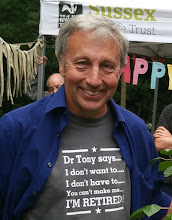My last blog posting outlined my general concerns about our throw-away society, in particular highlighting concerns about the proposed Laybrook landfill site as an example of the damage that can be done. I do not know the site but I had an excellent comment back from Pip Edgcombe who has clearly done significant research in the area.
I think this is a comment well worth reading so rather than leaving people to click on the comments box, I though I'd just publish it word for word as a separate blog posting:
This hole in the ground, Laybrook brickworks, does have significant existing wildlife interest. Far from being a barren quarry devoid of life, the varied mosaic of different habitats in and around the brickworks and the fact that it remains relatively undisturbed for much of the time has resulted in a site which supports a diverse mix of invertebrate, bird and mammal species. Many of the UK Biodiversity Action Plan priority species and other high conservation species are represented.
23 bird species with high conservation status were recorded by Cory's consultants (ESL) but based on other records and local knowledge this is a very conservative figure, it could be as high as 45.
There is a considerable bat population at the site with 8 species (including barbastelles) being recorded by ESL at the site and another over the adjacent fishing ponds. Many of the foraging habitats and the hedges used as flight lines by the bats will be destroyed. Work being undertaken at Knepp indicate that ESLs records are incomplete.
Water voles are also present on the site. There are very few colonies anywhere in the Adur, and the existing populations are extremely fragmented and vulnerable to extinction. The proposed landfill, rather than affording protection that is required by law, will result in the total destruction of their habitat.
As far as invertebrates are concerned the site is incredibly rich which is why it can support so many other species. Of the 565 species recorded by ESL, 60 have formal conservation status. ESL themselves describe it as a ‘site with a wide diversity of invertebrate interest’. The reason there are so many insects is because of the wide variety of habitats. Most of these will be destroyed during the construction and running of the landfill site. Mitigation measures are proposed to replace the hedges and plant new trees. However the current habitats have developed over tens, probably hundreds of years. They cannot be replaced overnight. The result will be habitat simplification, with a concomitant simplification of biodiversity that again the more common, competitive, species at the expense of far rarer niche-specialists. In addition, there will be a considerable delay before any restoration is carried out and be functional even at a basic level.
Landfill gas, landfill gas flare emissions, leachate, polluted surface water, dust, litter, noise and vermin are known to impact flora and fauna. Planning permission for the landfill should be refused as it is not needed and not wanted but also on the basis that this is an area of great biodiversity value, the ecology reports submitted by Cory's consultants are not complete and that the full impact on the ecology of the brickworks and the surrounding area has not been assessed.
Very many thanks, Pip, its good to have an insight from someone who knows the area.
Wednesday, 2 September 2009
Subscribe to:
Post Comments (Atom)

No comments:
Post a Comment